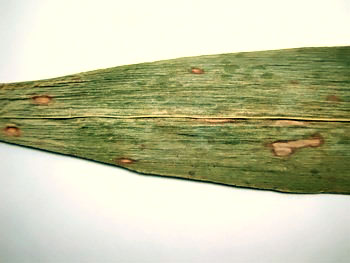Diseases
Helminthosporium maydis Nisik. & Miyake - Southern Corn Leaf Blight
Systematic position.
Class Ascomycota, subclass Dothideomycetidae, order Pleosporales, family Pleomassariaceae, genus Helminthosporium.Biological group.
It is a facultative parasite.Morphology and biology.
The disease affects leaves, leaf sheaths, ear, and maize grains. The lesions on leaves and ears are the main symptoms of the disease. On leaves of adult plants the grayish-red or stramineous long lesions with dark brown center appear along leaf veins, being spindle-shaped or elliptical. The length of the lesions is 40 mm, and their width is about 6 mm. The lesions can coalesce, causing death of leaves. On sheaths the lesions are brown with purple border. The length of the lesions is 50 mm. On ears the lesions are spindle-shaped, brown with dark border. The germ part of seeds becomes dark, and the seeds lose germinating ability. Besides maize the pathogen affects sorghum. Infected seeds and corn residues are sources of the infection. Conidia are curved, elliptical, from light-olive to brown. The size is 25-115 x 8.5-20.6 microns. Wind spreads the spores long distance. The fungus has the teleomorph Cochliobolus heterostrophus (Drechsler) Drechsler. It produces a specific T-toxin causing the same symptoms of disease as those caused by conidia.Distribution.
The first epidemics of the Southern Corn Leaf Blight took place in the USA in 1970. A highly virulent strain called Race T appeared on maize hybrids with Texas male sterile cytoplasm. In 1977-1980 the disease was found in Alania, in 1985-1989 in Krasnodar, Stavropol, Primorskii Territories, in Kabardino-Balkaria, Chechnya and Ingushetia, Ukraine, Kursk, Belgorod, Moscow, and Leningrad Regions. The disease development was related to the growing of maize with T-cytoplasm on large areas. In Krasnodar Territory only 70% of maize sowings were characterized as having T-cytoplasm. Since 1990 the use of cultivars with T male sterile cytoplasm has been forbidden in selection. Presently the cultivars with M and C types of sterility are used.Ecology.
The fungus develops at a wide range of temperatures, from 10 to 36.C. Optimum temperature for disease development is 25-31.C. Plants are infected at 90-100% humidity. The disease only develops in zones with high humidity (where annual sum of atmospheric precipitation is 800 mm and more). At high temperatures and humidity the sowings can perish over a period of 10-14 days.Economic significance.
The Southern Corn Leaf Blight is a quarantine disease in Russia. To protect the maize from the disease the following measures are recommended: removal of infected maize residues; crop rotation; removal of crop residues that contain the infection; use of disease-resistant hybrids of maize; treatment of grain and sowings with fungicides.Reference citations:
Aleksandrov I.N. 1991. Potential zones for acclimatization and damage of Southern Corn Leaf Blight on the USSR territory. Bykovo: VNIIK. 113-137 p. (In Russian)Aleksandrov I.N. 1992. The problem of Southern Corn Leaf Blight and methods of its decision. V. 2. Problems of plant quarantine. Bikovo: VNIIK. 103-107 p. (In Russian).
Erokhina S.A. 1990. Southern Corn Leaf Blight. Kukuruza i sorgo, 3: 45-48. (In Russian)
Gopalo N.M., Sokolov M.S., Chuprina V.P., Kobileva E.A. 1955. Damage of helminthosporium leaf lesions on maize, their epiphytotiology and protection of sowing. Agrokhimiya, 3: 101-119. (In Russian)
Kiryuchina R.I., Scherbakova L.I. 1975. Southern Corn Leaf Blight - dangerous disease of maize. Kukuruza, 6: 27-28. (In Russian)
Sotchenko V.S., Ivashchenko V.G., Lim K.G., Gorbacheva A.G. 1998. More attention to Southern Corn Leaf Blight. Kukuruza i sorgo, 5: 12-14. (In Russian)
© Levitin M.M.


